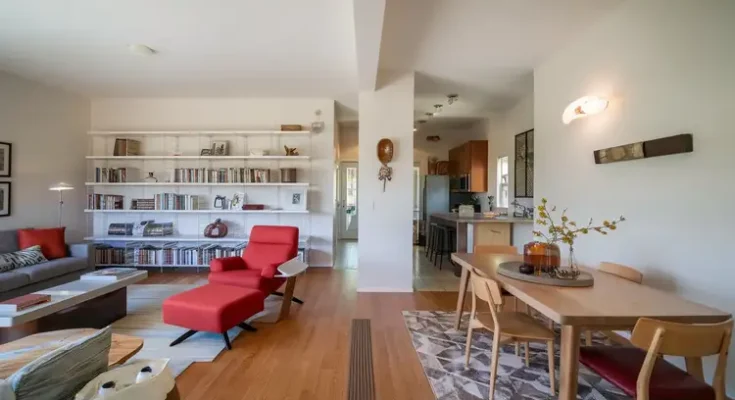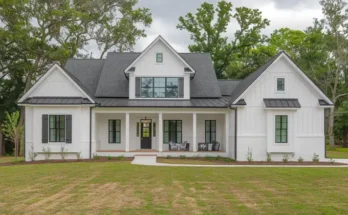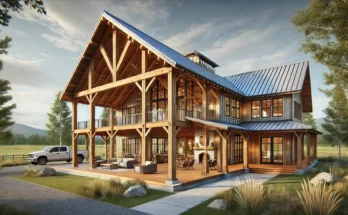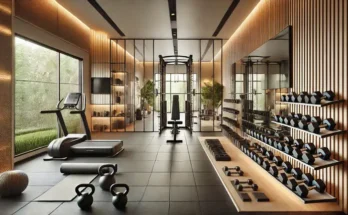Introduction
The main characteristic of modern house architecture consists of creating spaces free of any boundaries between rooms. The open floor plan contains every aspect of this design concept making it ideal for constructing new houses along with renovating existing ones. Wanderers of open floor plans can find their answers here because we unpack both the reasons behind its increasing demand and the associated difficulties with the type of design. This article includes information about benefits alongside required design elements and typical formats and complete integration methods for home spaces.
What Is An Open Floor Plan?
Eliminating the barrier that walls provide, the open floor plan dispenses any vertical obstructions between the central living areas. Combining the kitchen, the dining room and the living room is a perfect example. With everything being connected, instead of a few isolated rooms there is a rather larger, spacious area to function in. This excites fluid motion, an abundance of natural lighting and an overall feeling of connection and blend within the house.

The open floor plan has become increasingly common in today society, particularly in modernistic/classic open space homes. The design fosters flexible space usage as well as family togetherness. Nevertheless, while designing the layout there are a number of points that must be considered in order to find a balance between comfort and order.
Advantages of an Open Floor Plan House
1. More Space Efficient
The most significant advantages of these design and layout is how efficiently it occupies space. Open spaces work especially well for small and medium homes since they do not require an overwhelming number of walled establishment and closed off rooms. In such homes especially in urban context space is always at a premium thus aiding the open plan in such situations.
Also, considering the fact that such layouts are very conducive in enabling change, furniture and other facets of the house can be adjusted and relocated to meet the needs of the family. Unnecessary space wasting extensions like halls and doors would serve no use and can be avoided, thus ensuring optimal use of space.
2. Enhanced Communication
The design of an open floor plan promotes open interaction. For instance, talking to your friends in the living or dining area is possible while cooking in the kitchen. This reduces the sense of segregation in some of the spaces in the house. This fluidity increases the number of social interactions available in the house.
This is especially useful for parents with little children or individuals who love hosting guests. Open floor plans are welcoming and all members of the family can easily take part in the events no matter where they are.
3. Increased Sunshine Exposure
Removing walls enables sunshine to penetrate various rooms in the space. On a bright day, there will be lots of light from French doors or large windows without walls to the room. Sunlight boosts mood, increases performance and improves one’s self image.
Furthermore, large or vaulted spaces may also be part of the open floor design which will then allow extra sunlight to enter the home than with a closed floor design. As a consequence, the space feels larger, the walls everywhere look brighter than they would in a closed floor plan.
4. Recent Aesthetic
In the last few decades, open floor plans have become the epitome of modern home renovation and construction. A minimalist approach incorporating clean lines and no internal walls turns a space look and feel contemporary. These areas usually come with chic interiors, refined structural design as well as an easy transition from one area to the other. Open floor plans appeal to simplicity and elegance in a place.
Design Name | Size (sq ft) | Features |
Open Haven | 320 | Wide Living Space, Large Glass Doors |
Spacious Loft | 350 | High Ceilings, Open Kitchen |
Airy Abode | 380 | Minimalist Design, Natural Light |
Furthermore, not having physical divisions between rooms allows for cohesive vision in the interior design of the house. Generally, the theme of a house is preserved wout compromising its style. All the elements, such as the color and the paint of the house, fit perfectly.
5. Multi-Dimensioned Nature
The open floor plan comes with amazing degrees of freedom in terms of detailed design and enhances functionality. A good example is creating multi-functional zones for entertaining and relaxed activities that would otherwise have to be separated by walls and dividers. With an open floor plan, one can turn a kitchen and dining area into an integrated space with a free flow in all three areas and can be switched according to the occasion.
An open floor plan combined with no designated furniture types allows a fresh rentensioned space. No matter if you want a conservative set up or innovative and extreme look, mix and match options with the floor plan means one can easily set up the area to better fit themselves.

Practical Design Elements for Open Floor Plans
1. Zoning
Even though open floor concept does away with walls separating rooms, appropriate zoning for the larger space is needed. This can be done by arranging furniture, using area moquettes, using lights and even changing floor materials. You can use a sofa to delineate the living zone or define the dining area with a dining table away from the kitchen for example.
Adequate zoning of open space works best when different functional areas are specially located and still provide a link with one another. This allows each zone to perform their intended use without being in isolation.
2. Lighting Fixtures
Jennifer Williams In a living room with an open floor plan, lighting can be used to enhance different areas. Large attractive pendant lights or even chandeliers can attract attention, particularly in the kitchen and dining areas. Also, pendant light hung over a kitchen island helps to visually differentiate the cooking area from the rest and does not block the flow.
Also, wall-fixed lights, floor lamps and recessed lighting can assist in setting the mood and also provide emphasis lighting where appropriate. This makes sure that the ceiling of the open plan remains uniformly lit and interesting to the eyes.
3. Application of Color and Texture
Open floor plans establish interest visually with the appropriate use of color and texture. Colors can either be entirely homogenous or variated, with the latter containing zestful elements which help divide structures in a more understated subtle approach, for example having a darker paint in the living room and warm light shades in the kitchen or dining area. In doing so, it makes sure each section has a unique touch while also giving a cozy feeling when in the living room.
A contrast of diametrically positioned styles like soft fabrics of couches along marble surfaces or wooden floors, create a refreshing element within the location. By combining textures and mixes of materials, you can construct open interiors and designs that feel alive and exciting.
4. Multi-Functional Furniture
Apart from being multifunctional, the furniture in open floor plans also maximizes the area of the room available. So, look for furniture like storage sofas, tables that can be retrieved during large gatherings. The modular furniture that is able to be reversed or shifted depending on what works best is also ideal to save space and make sure that an open space design will function at its maximum capacity.
5. Stress on Flow and Continuity
One of the central objectives of designing an open-floor plan is the integration of multiple zones. This is done through both design features and flow. For instance, remove doorways and the arrangement of furniture that disrupts the flow of the space. The goal is for people to navigate between the areas without feeling there are any barriers in place.

Most Common Open Floor Plan Designs
1. The Great Room Concept
One of the well-recognized designs of an open concept floor plan is the idea of The Great Room, where the kitchen, dining and living area are combined and exist as one large area. Ideal for those who entertain frequently or enjoy wide spacious areas. The kitchen most of the time has an island as well or a breakfast bar whereby it separates the kitchen from the rest of the house somewhat.
2. Loft Type Open Floor Plans
Loft type open floor plans generally have high ceilings, large windows and a mixilevel feel. These kind of layouts are commonly found in city apartments as well as renovated lofts. Spaces of this kind are designed to be more open and meandor as much natural light as possible to make the space feel modern and light.
3. Split-level Open Floor Plan
This is the kind of plan where various levels within the open area of the house join with some stairs. For example, the living room can be up from the kitchen, meaning two sections, but again this doesn’t have to be separating them with any walls. This type of layout is excellent for structures built on a slope or for those with different designs.
4. The Kitchen-Centered Open Floor Plan
The open floor concept contains kitchen-oriented floor plans that we have previously mentioned. Inside this house arrangement the kitchen receives central focus which results in expansive counters, a central island and apparatuses of storage covering every space. The modern house links its living room with the dining room by placing these spaces next to the kitchen area. Such design suits all people who want to gather for food preparation and chefs or enjoy watching others prepare meals.
Design Name | Size (sq ft) | Features |
Breezy Retreat | 340 | Seamless Indoor-Outdoor Flow, Vaulted Ceilings, Open Kitchen |
Challenges of Open Floor Plans
1. Noise Control
Open floor plans face noise-related difficulties because they have fewer separating walls. The transfer of audial signals remains effortless to the point where dining room and kitchen visitors face disruptions. Soft textile elements such as rugs and curtains along with upholstered furniture act as sound absorbers in this situation. Partitioning empty spaces together with the strategic positioning of big plants helps in creating better acoustic separation between different areas.
2. Lack of Privacy
Messy multi-room apartments can at times be barely private as they encourage socialization. Bathrooms and bedrooms are generally kept aside, however, rooms like the preparing area or a study may not provide much privacy. There are strategies such as using bookshelves, glass walls or plants which can mask the room and make it feel semi segregated to increase the privacy.
3. Creating an Unified Theme
Achieving unity will be a major challenge for an interior designer if the apartment has been designed on a larger scale with an open floor plan. Designing comprehensively means looking at an area from different angles and elevating it’s aesthetic. Rich in color and style the coffee tables, curtains, chair and whatever else cognates themselves to the room can help make spaces feel endless.

FAQs
What else can you gain belonging an open floor plan apartment?
Modern designs have dispersed their mark in regions and this includes Indian urban spaces where open floor apartments are now more favored. They are known to be more controllable giving space strength, space efficiency, light enhancement and comfort more predominance.
There are way too many rooms how can I make it easy to move and insulate the memories?
Installing sliding doors can reduce noise and also provide discretion when required, furniture boundaries, floral curtains and plants also provide excellent insulation from disturbance when needed.
Do open floor plans use more energy?
Certainly, open floor plans can be energy-efficient provided it is properly designed to use natural light, insulated well, fitted with energy-efficient windows and equipped with smart HVAC systems.
What are the other issues open floor plans pose?
Other issues include privacy, noise control and ability to provide and maintain a well-integrated design for larger open areas.
Conclusion
Various advantages exist for open floor plan home ownership which produce space optimization and facilitate more household connections alongside superior interior design improvements. The design will incorporate strategically positioned lighting and well-zoned furniture placement among other elements to achieve functional beauty in the setup. The open plan strategy will transform your residence with modern spaciousness either by constructing a new house or renovating an existing one.




